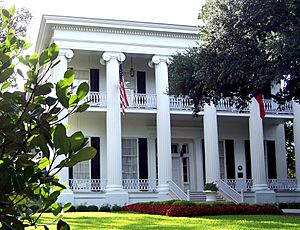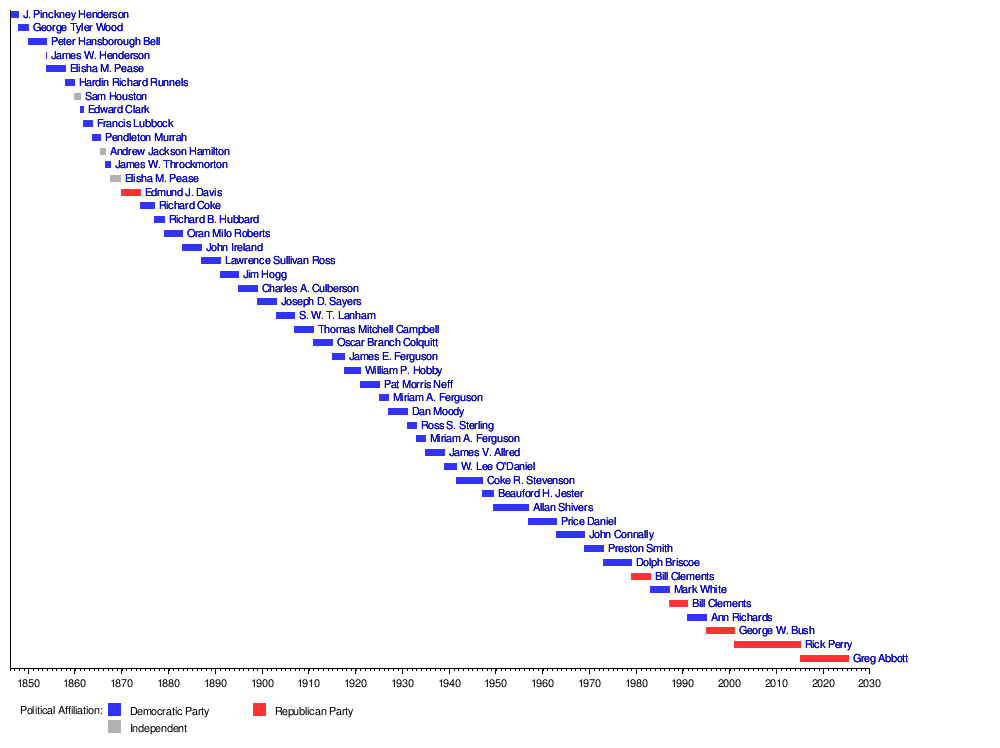Governor of Texas facts for kids
Quick facts for kids Governor of Texas |
|
|---|---|

Standard of the governor
|
|

Seal of the governor
|
|
|
|
| Style |
|
| Residence | Texas Governor's Mansion |
| Seat | Austin, Texas |
| Appointer | Popular vote |
| Term length | Four years, no term limit |
| Constituting instrument | Constitution of Texas |
| Precursor | President of the Republic of Texas |
| Formation | December 29, 1845 |
| First holder | James Pinckney Henderson (1846) |
| Deputy | Lieutenant Governor of Texas |
| Salary | $153,750 (2019) |
The governor of Texas is the head of government of the U.S. state of Texas. The governor is the head of the executive branch of the government of Texas and is the commander-in-chief of the Texas Military Forces.
Established in the Constitution of Texas, the governor's responsibilities include ensuring the enforcement of state laws, the power to either approve or veto bills passed by the Texas Legislature, overseeing state agencies, issuing executive orders, proposing and overseeing the state budget, and making key appointments to state offices. The governor also has the power to call special sessions of the legislature and, with the recommendation of the Texas Board of Pardons and Paroles, grant pardons.
The current governor of Texas is Republican Greg Abbott, who took office in 2015.
Contents
Qualifications
Article IV, Section 4 of the Constitution of Texas sets three qualifications for candidates for governor of Texas:
- Be at least 30 years old;
- Be a citizen of the United States;
- Be a resident of Texas for at least five years preceding the election.
Election, oath of office and removal
Governors of Texas are directly elected by registered voters in Texas and serve terms of four years, with no term limits. Before executing the powers of the office, a governor is required to recite the oath of office as found in Article XVI, Section 1 of the Constitution of Texas:
I, _______________________, do solemnly swear (or affirm), that I will faithfully execute the duties of the office of governor of the State of Texas, and will to the best of my ability preserve, protect, and defend the Constitution and laws of the United States and of this State, so help me God.
They take office on the third Tuesday of January following an election, which is also the date of expiry of the previous gubernatorial term.
Removal of a governor from office
The Texas governor can be impeached by the State House of Representatives for committing treason, bribery, or any other high crime or misdemeanor. Once the governor is impeached, the case is forwarded to the State Senate for trial. A two-thirds majority vote in the Senate is required to remove the governor from office. Unlike other states, Texas does not have a provision in the state constitution that allows voters to petition for a recall election to remove the governor.
History
The state's first constitution in 1845 established the office of governor, to serve for two years, but no more than four years out of every six (essentially a limit of no more than two consecutive terms). The 1861 secessionist constitution set the term start date at the first Monday in the November following the election. The 1866 constitution, adopted just after the American Civil War, increased terms to 4 years, but no more than 8 years out of every 12, and moved the start date to the first Thursday after the organization of the legislature, or "as soon thereafter as practicable". The Reconstruction-era constitution of 1869 removed the limit on terms, Texas remains one of 16 states, territory or jurisdiction (including the U.S. Territory of Puerto Rico and the District of Columbia) with no gubernatorial term limits. The present constitution of 1876 shortened terms back to two years, but a 1972 amendment increased it to four years again.
The gubernatorial election is held every four years on the Tuesday after the first Monday in November that does not coincide with the presidential elections. All gubernatorial elections have been a part of the midterm elections since the 1974 election, invalidating the latter. The governor is sworn in on the third Tuesday of January every four years along with the lieutenant governor, so Abbott and current lieutenant governor Dan Patrick both took office on January 20, 2015.
Despite the lack of term limits, no Texas governor in the 19th or 20th century ever served more than seven and a half consecutive years in office (Allan Shivers) or eight years total service (Bill Clements, in two non-consecutive four-year terms). Former governor Rick Perry, who served from 2000 to 2015, surpassed both these records, becoming the first Texas governor to serve three consecutive four-year terms. When Perry won the general election on November 2, 2010, he joined Shivers, Price Daniel, and John Connally as the only Texas governors elected to three terms (the terms served by governors Shivers, Daniel, and Connally were two-year terms). On November 8, 2022, current governor Greg Abbott was re-elected and became the fifth Texas governor to serve three terms following Shivers, Daniel, Connally and Perry. In case of a vacancy in the office of governor, the lieutenant governor becomes governor. This rule was added only in a 1999 amendment, prior to which the lieutenant governor only acted as governor, except during the time of the 1861 constitution, which said that the lieutenant governor would be styled "Governor of the State of Texas" in case of vacancy.
Official residence and workplace

The official residence of the Texas governor is the Texas Governor's Mansion, in Austin. The mansion was built in 1854 and has been the home of every governor since 1856. It is also one of the official workplaces for the governor.
The governor's primary official workplace is located within the Texas State Capitol in Austin.
Timeline of governors of Texas
The following timeline depicts the progression of the governors of Texas and their political affiliation at the time of assuming office.

Line of succession
The governor of Texas line of succession is set by Article IV, Sections 3a and 16–18 of the Constitution of Texas and Chapter 401.023 of Title 4 the Texas Gov't Code.
| No. | Office | Current officeholder | Party | |
|---|---|---|---|---|
| 1 | Lieutenant Governor | Dan Patrick | Republican | |
| 2 | President pro tempore of the Senate | Charles Schwertner | Republican | |
| 3 | Speaker of the House of Representatives | Dustin Burrows | Republican | |
| 4 | Attorney General | Ken Paxton | Republican | |
| Chief Justices of the Texas Courts of Appeals, in numerical order | ||||
| 5 | 1st Court of Appeals (Houston) | Terry Adams | Republican | |
| 6 | 2nd Court of Appeals (Fort Worth) | Bonnie Sudderth | Republican | |
| 7 | 3rd Court of Appeals (Austin) | Darlene Byrne | Democratic | |
| 8 | 4th Court of Appeals (San Antonio) | Rebeca Martinez | Democratic | |
| 9 | 5th Court of Appeals (Dallas) | Robert Burns III | Democratic | |
| 10 | 6th Court of Appeals (Texarkana) | Josh Morriss | Republican | |
| 11 | 7th Court of Appeals (Amarillo) | Brian Quinn | Republican | |
| 12 | 8th Court of Appeals (El Paso) | Jeff Alley | Republican | |
| 13 | 9th Court of Appeals (Beaumont) | Scott Golemon | Republican | |
| 14 | 10th Court of Appeals (Waco) | Tom Gray | Republican | |
| 15 | 11th Court of Appeals (Eastland) | John M. Bailey | Republican | |
| 16 | 12th Court of Appeals (Tyler) | Jim Worthen | Republican | |
| 17 | 13th Court of Appeals (Corpus Christi) | Dori Contreras | Democratic | |
| 18 | 14th Court of Appeals (Houston) | Tracy Christopher | Republican | |
See also
 In Spanish: Anexo:Gobernantes de Texas para niños
In Spanish: Anexo:Gobernantes de Texas para niños
- List of governors of Texas
- List of Texas governors and presidents
- List of presidents of the Republic of Texas
- List of lieutenant governors of Texas
- List of Texas state agencies


